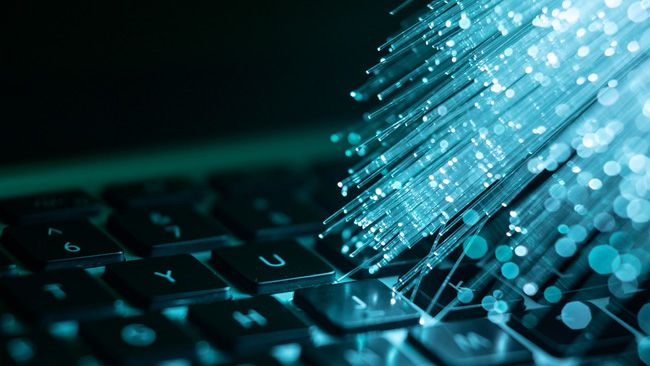One thing that has taken the technology world by storm is fiber-optic internet. This type of connection isn’t like the traditional cable lines. Instead, it’s faster and more reliable by using a light signal. The thread itself doesn’t carry the electrical signal, but it does offer more protection with glass filaments compared to other types of lines that are used. A benefit of fiber optic lines is that they don’t deteriorate as quickly over time, which allows for a steady internet connection that’s delivered to your home if you choose this type of connection for your internet. It also results in a faster speed. As with other connections, there are a few negative aspects to consider with fiber-optic lines just as there are positive aspects to consider.
Pros
Connection
A fiber-optic line is a bit more resistant to electrical interference from outside sources compared to cable lines. If there’s an electromagnetic disturbance that occurs, then it can result in a disruption of the performance of the internet connection. Several items can carry this kind of disturbance including the sun and power lines. Since fiber-optic lines are usually buried in the ground and because of the glass filaments that protect the transmissions that are sent, they are more resistant to these electrical interferences.
Scalable
A fiber-optic line is a little easier to scale, which means that it can be easier to install in tighter spaces compared to cable lines. The wavelengths that flow through the lines can be turned off and on when needed due to the demand for services. These services can also be adjusted for large communities or businesses that might need an upgrade without the need for installing more lines. Lines can usually be placed so that they can last for about 20 years so that they don’t need to be replaced when more services are needed.
Secure
Whether you use the internet at home or at your business, you need to have a safe connection. Signals aren’t given off by fiber-optic lines, which makes it harder for transmissions to be sent to other networks aside from your own. If there’s any kind of break or disturbance in the lines, it’s often easy to detect, which can result in faster repairs so that internet services aren’t down for very long. If there is a larger break, then it could result in the entire system failing, but since failures are typically easy to spot, then the failure can usually be easily repaired compared to replacing cable lines. The maintenance and regulation of the fiber optic lines are often kept in one place instead of spreading the lines and equipment out over a longer distance, making the process of maintaining internet connections as secure and simple as possible.
Costs
A fiber optic internet network usually doesn’t require the same maintenance and overhead as copper lines or other materials that are used with cable internet or with a satellite system. While a fiber system is often more expensive when it’s installed and connected, the overall maintenance process isn’t as expensive because it can be easily scaled to meet the needs of the community or businesses. With more companies using fiber-optic lines, the price associated with the materials and connections should begin to decrease over time so that companies can stay competitive.
Cons
Even though there are several advantages of using fiber optic internet lines, you need to look at the disadvantages of this type of connection as well before making a final decision about the kind of connection that you want for your home or business.
Damage
Since fibers are delicate and thinner than cable lines, it can make the lines easier to damage if someone were to cut into them. The most common situation that involves cutting these lines is when a remodeling project is being completed or if rewiring is taking place. Data is transmitted faster and in a higher quantity than with traditional cable lines, which means that more people can be served in one area at a time. However, if the lines are damaged, this means that more people would be impacted by an outage until the lines are repaired. Another disadvantage when it comes to damage is that fiber doesn’t want to bend as easily as cables, making it difficult to get the lines around corners of buildings or around turns. They are also a bit more susceptible to exposure to chemicals and radiation, which can deteriorate the lines if they are exposed for long periods of time.
Costs Over a Short Time
Fiber lines can be expensive to initially install even though the price is starting to trend downward. It usually takes special equipment to test the lines to ensure that they are working properly or to detect if there’s an issue with the lines that need to be repaired. Since special equipment needs to be used when the lines are initially installed and if problems arise with the equipment, it can result in higher costs over a shorter time until the system is back online.
Fusing
There’s an issue called “fiber fuse” that’s connected with fiber-optic lines. If there’s too much light that reaches an imperfection in the fiber lines, then it can begin destroying the entire line over time if it’s not fixed.
Lighting
Light can only be propagated throughout fiber lines in one way. Sometimes, communication needs to be sent in two directions instead of only one. This means that there would need to be two different cables that are installed so that the information can be sent one way through one cable and the other way through the other so that the information doesn’t overlap. This increases the chance for more damage to the lines since there are more involved, and it can also make it a bit more difficult to actually install the lines since they have to be placed in a careful manner without bumping into each other. More money is also spent because there are two lines that are placed instead of one.




Leave a comment
Have something to say about this article? Add your comment and start the discussion.